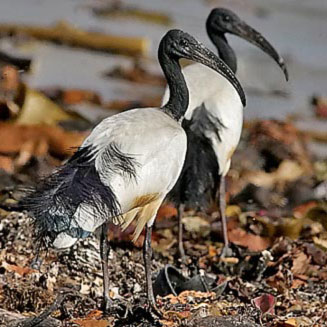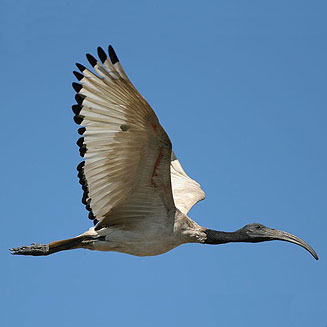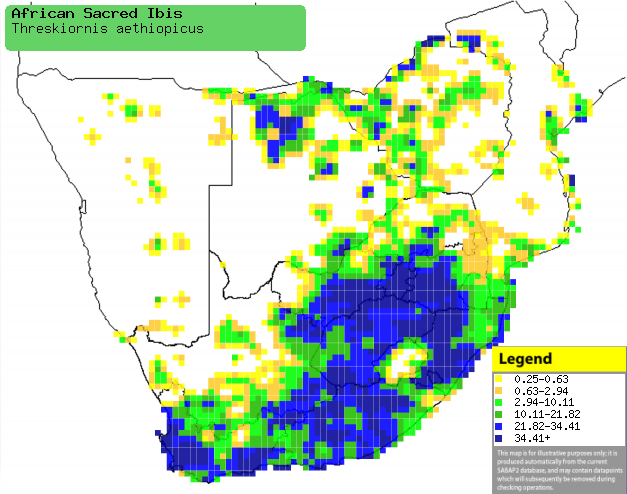Threskiornis aethiopicus
(African sacred ibis, Sacred ibis)
Skoorsteenveër [Afrikaans]; umXwagele (generic
term for ibis) [Zulu]; Ndingilira [Kwangali]; Lehalanyane,
Leholotsoane [South Sotho]; N'wafayaswitlangi [Tsonga]; Heilige ibis
[Dutch]; Ibis sacré [French]; Heiliger ibis [German]; Ibis-sagrado
[Portuguese]
Life
> Eukaryotes >
Opisthokonta
> Metazoa (animals) >
Bilateria >
Deuterostomia > Chordata >
Craniata > Vertebrata (vertebrates) > Gnathostomata (jawed
vertebrates) > Teleostomi (teleost fish) > Osteichthyes (bony fish) > Class:
Sarcopterygii (lobe-finned
fish) > Stegocephalia (terrestrial
vertebrates) > Tetrapoda
(four-legged vertebrates) > Reptiliomorpha > Amniota >
Reptilia (reptiles) >
Romeriida > Diapsida > Archosauromorpha > Archosauria >
Dinosauria
(dinosaurs) > Saurischia > Theropoda (bipedal predatory dinosaurs) >
Coelurosauria > Maniraptora > Aves (birds) > Order:
Ciconiiformes
> Family: Threskiornithidae
 |
 |
| African sacred ibis. [photo
Jeff Poklen
©] |
African sacred ibis, Intaka Island Wetland
Reserve, South Africa. [photo Trevor Hardaker ©] |
Distribution and habitat
Occurs across much of sub-Saharan Africa; in southern
Africa, it is common in northern and eastern
Botswana, the Caprivi Strip (Namibia), Zimbabwe, Mozambique and much of South
Africa. It generally prefers the margins of
inland freshwater wetlands, coastal lagoons, the intertidal zone,
offshore islands, grassland, open habitats and man-made habitats, such as
cultivated land, dams, sewage works, lawns, farmyards, refuse tips and
abattoirs.
|
 |
|
Distribution of African sacred ibis in southern Africa,
based on statistical smoothing of the records from first SA Bird Atlas
Project (©
Animal Demography unit, University of
Cape Town; smoothing by Birgit Erni and Francesca Little). Colours range
from dark blue (most common) through to yellow (least common).
See here for the latest distribution
from the SABAP2. |
Predators and parasites
- Predators of eggs and chicks
Movements and migrations
Largely sedentary, although it may make nomadic
movements in response to localised rainfall.
Food
It mainly eats invertebrates, doing most of its foraging on
moist ground, probing the soil or snapping up prey from the ground surface. The following food items have been recorded
in its diet:
- Invertebrates
- insects
- earthworms
- molluscs
- Vertebrates
Breeding
- Monogamous, breeding in groups ranging from a few to roughly 1500 pairs,
often within a large mixed-species colony along with
storks,
herons, African spoonbills,
African darters and
cormorants. It may also form a
tightly packed single-species colonies in trees and bushes, on offshore
islands or even in abandoned buildings.
- The nest is built by the female with material provided by the male,
consisting of a large platform of sticks and branches or reed and sedge
stems, lined with leaves, grass and other soft material.
- Egg-laying season is almost year-round, peaking from August-March.
- It lays 2-5 eggs, which are incubated by both sexes for roughly 28-29
days.
- The chicks are cared for by both parents, one of whom are always present
at the nest for the first 7-10 days of the chicks' lives. They leave the
nest at 14-21 days old to form small groups nearby, fledging at 35-40 days
old and leaving the colony at 44-48 days old.
Threats
Not threatened.
References
-
Hockey PAR, Dean WRJ and Ryan PG 2005. Roberts
- Birds of southern Africa, VIIth ed. The Trustees of the John Voelcker
Bird Book Fund, Cape Town.
|
